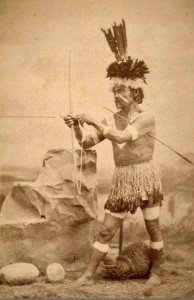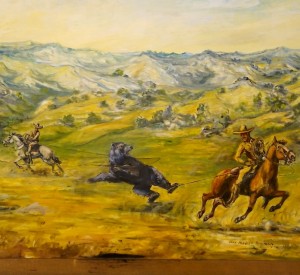Posted on October 19, 2015
San Luis Obsipo: Grizzly Bears and Flaming Arrows
At San Luis Obispo, we were received by a strong circle of Northern Chumash families and other local native and non-native people, some from as far away as the Kern Valley Indian Community in Bakersfield. Chairwoman Mona Olivas Tucker of the Yak Tityu Tityu Northern Chumash tribe opened the circle with a prayer in the Chumash language.
“We’re here to greet you, to welcome you, and to show our support,” Mona said. “We’re from this area, this is where we were born, and our families have been here for at least 10,000 years. And I’m glad that we’re still here. We’re here always. And today, we’re thrilled to be a small part of your journey.”
“Now that the canonization is done, it doesn’t change anything,” Mona explained. “It doesn’t undo what was done in the past. And it doesn’t change our purpose, it doesn’t change our focus, it doesn’t change our goals and our aspirations: none of that’s changed.”
Caroline Ward-Holland agreed. “We need to stand together as California indigenous people and say, this is what we want done, and this is when we want it done. We’re going to have a voice. We want our burials to be respected. We want our sacred sites to be respected. Our story is not going to be hidden anymore, it’s not a secret. The curriculum needs to be changed. We need to tell our school systems: no more baby missions! Unless they’re telling the truth. We’re not going to take it anymore. And we have a lot of support, and a lot of people who stand in solidarity with us to make sure we will be heard.”
Cathleen Schenk Park spoke to the need for large institutions in California “that came in and rolled over lots of people” to donate resources for indigenous cultural revitalization programs, land acquisition, and the establishment of indigenous cultural centers. “We need to get them to see what’s happening and to start putting serious funding in, so we can build back up the culture, for the young people that are lost. Because when you’re culture’s stripped from you where do you go? That’s your foundation. Knowing who you are and where you came from: what could be more important?”
Chumash descendant Carlie Domingues shared a story about her experiences at Mission San Luis Obsipo. “I’ve come to this Mission my whole life. I came here as a Catholic, and I came as a child, to play in the creek. A few years back, I remember learning about how our people couldn’t sing or dance in the missions. That we were whipped when we would sing and dance, and they like, beat dancing out of us, is what I understand. A few months ago, nobody was here, and I was able to sing and pray over there. Just singing or dancing for that brief moment was a really good experience for me.”
“I always come to this creek,” Carlie continued. “And I’m really glad that you all are here and that we’re at this creek together. It means a lot to have people here that are remembering our people, that came to the missions. Because I sometimes feel like nobody remembers, when I’m walking down the street, you know?”
“I’m so grateful that this awareness has been raised, one person at a time,” walk supporter and Templeton resident Julie Belmonte shared as the gathering came to a close. “That’s the connection that we have: now, we can all share your stories. As non-native people, we don’t have it in our DNA, but we have it in our hearts. And our hearts are breaking with yours. And also, I feel so uplifted by you. So, thank you so much.”
Later in the evening we learned some illuminating stories regarding the early days of the San Luis Obispo mission. In 1772, Carmel and San Antonio missions were facing starvation, after a rough winter and the delay of supply ships from Mexico. Spanish soldiers were sent south to La Cañada de los Osos (Valley of the Bears), named for the abundance of grizzly bears in the area. They slaughtered all the bears they could find, sending 9,000 pounds of dried and salted meat back to Carmel and “nearly wiping [grizzly bears] out in the region on that one hunt.”1 Junipero Serra, impressed by the bounty of meat and the stories of large Chumash villages he could convert to Christianity and conscript as a labor force, marched south to establish a new mission in the area, which he named after Saint Louis of Anjou, a French bishop.
The original buildings of Mission San Luis Obispo were built with dry, tule-thatched roofs, the standard for all the California missions at the time. But those structures didn’t last long. According to the history page of the official SLO mission website, “…due to fires in the first few years, adobe and tile structures were erected.”

“Enemy Indians soon discovered the weakness of the roofs thatched with dry rushes.”4 (photo: Rafael Solares, a Santa Inez Chumash man, 1878.)
Due to fires? What they fail to mention is that these fires were the result of flaming arrows, fired by Chumash Indians who were “determined to drive the missionaries out of the area.”2 At night in November of 1776, flaming arrows lit the Padres’ quarters ablaze, and the fire soon spread, consuming all the buildings except for the chapel and a granary. Two leaders of the attack were caught and imprisoned at Monterey Presidio and extra guards were deployed at San Luis Obispo mission. Despite this, the “unfriendly natives” continued to attack the mission, reportedly setting buildings ablaze on at least two later occasions before a technological fix was employed:
"The missionaries, still under periodic attack from flaming arrows and remembering the tiled roofs of Spain, started to experiment with making roofing tiles to protect the structures against the arrows. Very quickly, all of the California missions adopted the tiles as part of their construction…"3
In conclusion, every time you see the Mission-style tile roofs that are so ubiquitous in California, don’t think of Spanish colonial glory. Think of flaming arrows!
- SF Chronicle, 8/20/15—Mission San Luis Obispo built on grizzlies’ turf. Quote from historian & Cal Poly San Luis Obispo professor, Dan Krieger.
- Simondi, Thomas E. "Mission San Luis Obispo History." MissionTour.org website, 17 May 2015.
- Ibid.
- The Tilemaker: A Tale of Mission San Luis Obispo by Helen M Roberts— pg. 4



